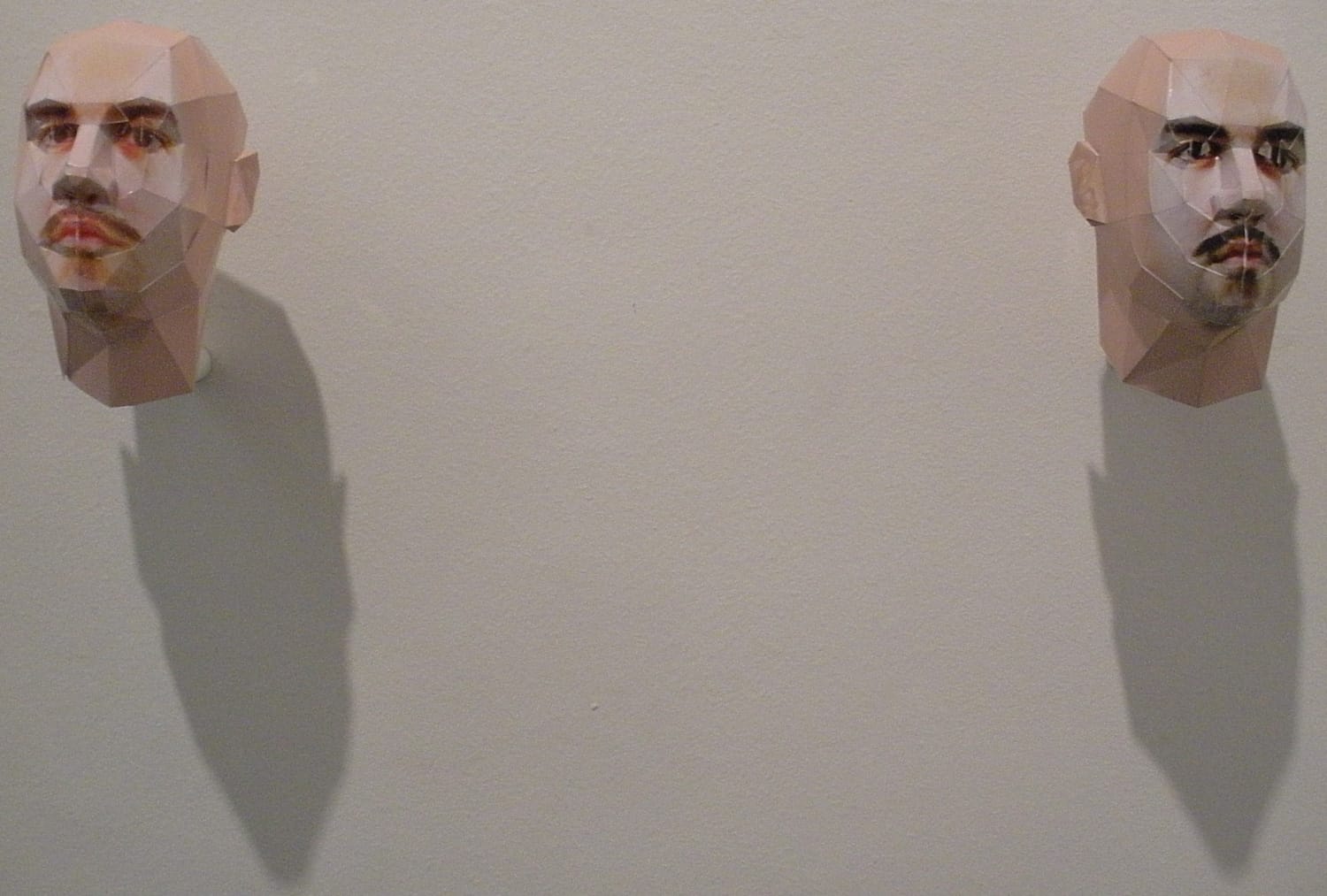HEADSHOTS por Camila Fialho

Em dimensões reduzidas e de mesmo tamanho, cabeças de papel se projetam no espaço expositivo na forma de esculturas fotográficas. Na parede, o mapa aberto de uma cabeça indica trajetórias possíveis de um jogo minucioso de dobraduras. A estranheza fixa a primeira impressão do olhar ao se deparar com as pequenas peças esculpidas por Marcelo Amorim.
Em meio à proliferação das mais diversas identidades virtuais das redes sociais do contemporâneo, o artista brinca na construção de um avatar múltiplo. Em seu trabalho, a foto 3×4, estampada cotidianamente em documentos de identidade, perde sua bidimensionalidade para ganhar textura e profundidade na modelagem virtual de uma cabeça. Esta, por sua vez, volta a ter duas dimensões quando aberta em um diagrama de polígonos, formando uma espécie de quebra-cabeças em tons de pele. E da tela do computador, a cabeça volta a existir na superfície de um papel fotográfico para então ser reconstituída materialmente através de delicadas dobras, como um origami de feições humanas. Em sua nova versão espacial, já não conseguimos mais identificar os traços do rosto que estava à origem da pequena escultura. Trata-se de um ser-objeto outro que materializado adquire um ar robótico. A substância humana identificável se apaga, e o que agora temos são cabeças cibernéticas volantes, cabeças quase suspensas, quase sem peso, cabeças ocas, despidas de uma identidade orgânica.
O bruto do objeto multifacetado alinhado com a sutileza dos tons de pele nos incita a buscar os traços humanos dissipados nas camadas de manipulação da imagem. Por mais que seja possível identificar feições de seu criador, o que vemos ali é um ser hesitante em suas definições. As dimensões do real suposto pela fotografia diluem-se nas mãos do artista dando uma nova roupagem a sua identidade. Talvez pudéssemos pensar em um autorretrato, mas as cabeças-objetos acabam por se explicar outras figuras, semelhantes, não iguais.
Headshot constitui-se no limiar de universos híbridos. Híbrido em seu processo que transita por diferentes mídias: da captação fotográfica, passando pela customização computacional, ao gesto físico e fino que devolve ao ser fotografado a materialidade de um rosto cibernético. Híbrido enquanto obra fotográfica e escultural. Híbrido ainda naquilo que nos evoca do identitário de nós mesmos que se desvanece na construção de novas realidades aparentes onde o real e o virtual, o natural e o artificial se confundem, onde a identidade se torna criação.
Smaller or same-sized paper heads are displayed in the exhibition room in the form of photographic sculptures. On the wall, the open map of a head shows possible trajectories of a detailed folding game. The first impression one gets by looking at the small pieces sculpted by Marcelo Amorim is strangeness.
Amongst the various different online identities of the social media of our time, the artist plays in building a multiple avatar. In his work, our 3×4 identity card photos are no longer two-dimensional, but rather provided with texture and depth to form a computer-modeled head, which becomes two-dimensional again when unfolded as a diagram of polygons, thus forming some kind of puzzle of skin shades. And, on the computer screen, the head reappears on the surface of photographic paper and is then materially reproduced by delicate folding, as an origami with human features. In its new spatial version, we no longer recognize the traces of the original small sculpture face. Materialized, this object/being becomes robotic-like. Identifiable human characteristics fade away, and all that is left are hollow, almost weightless cyber heads deprived of organic identity moving overhead.
The gross multifaceted object aligned with subtle skin shades makes us look for human traces faded away in the image’s handled layers. While it is possible to identify the features of its creator, what we actually see is a hesitating being in its definitions. The dimensions of what is real assumed by the photograph fade away in the artist’s hands and give its identity a new look. We might think of a self-portrait, but the object heads eventually define themselves as other figures, similar, not equal.
Headshot is the threshold of hybrid universes. Hybrid, because its process develops across different media: from the photo taking, through computer customization, to finally reach the fine physical aspect that gives back the photographed being the materiality of a cyber face. Hybrid as a photographic and sculptural work. Also hybrid, because it evokes in us the identity of ourselves that dispels when new apparent realities are built, where real and online, natural and artificial mingle, and where identity becomes creation.
Text published in 2012 in the catalog of the exhibition Abre Alas 8, held at A Gentil Carioca, in Rio de Janeiro

